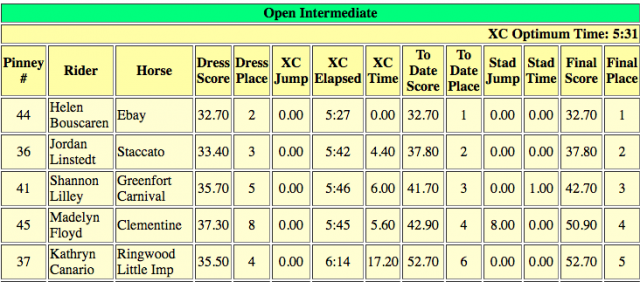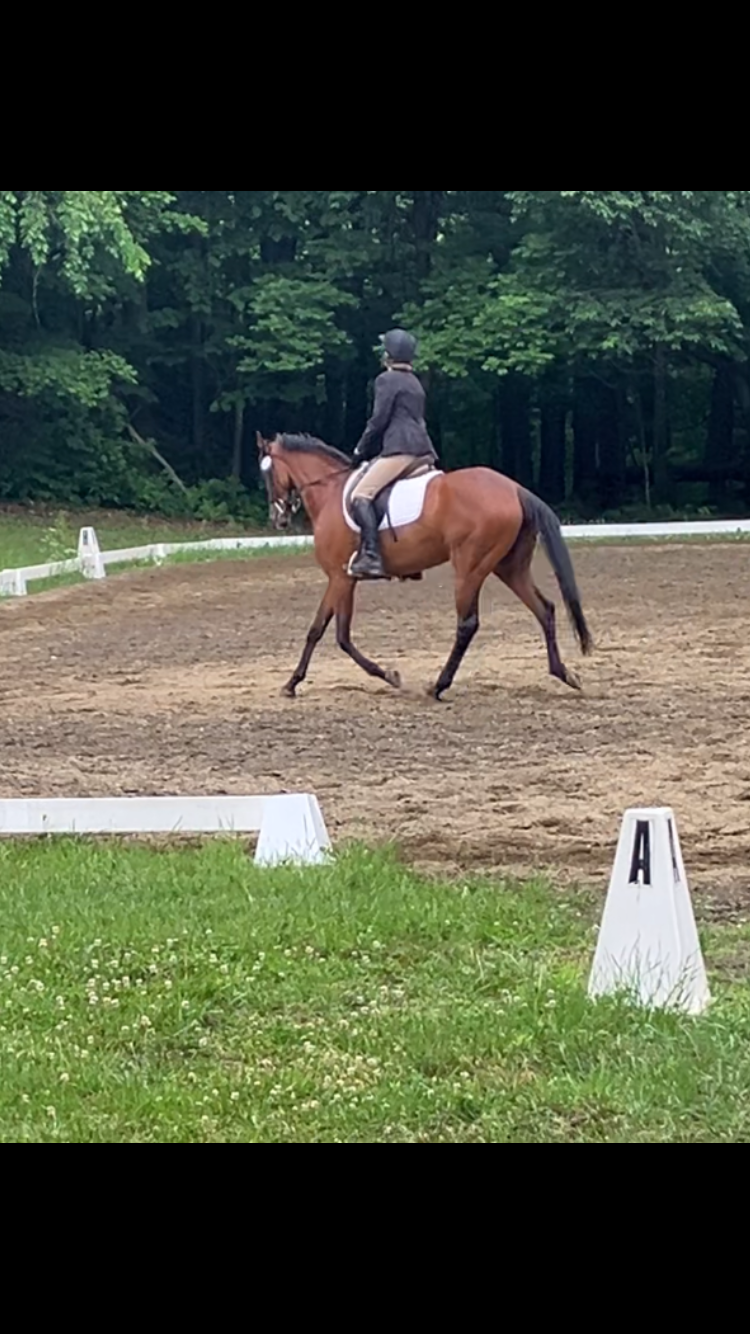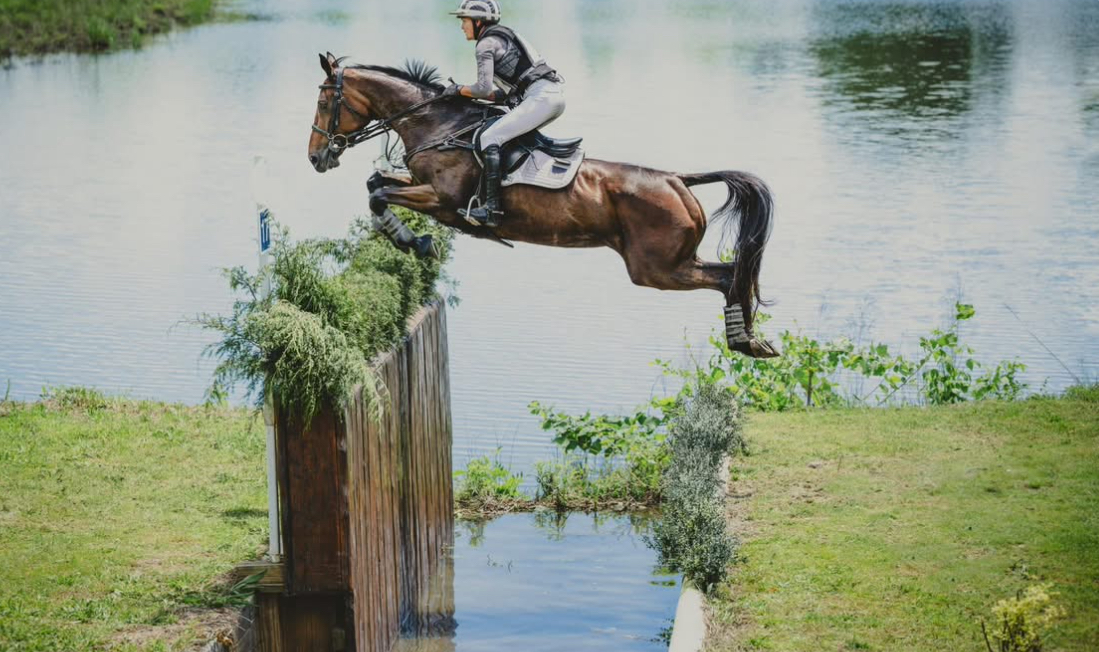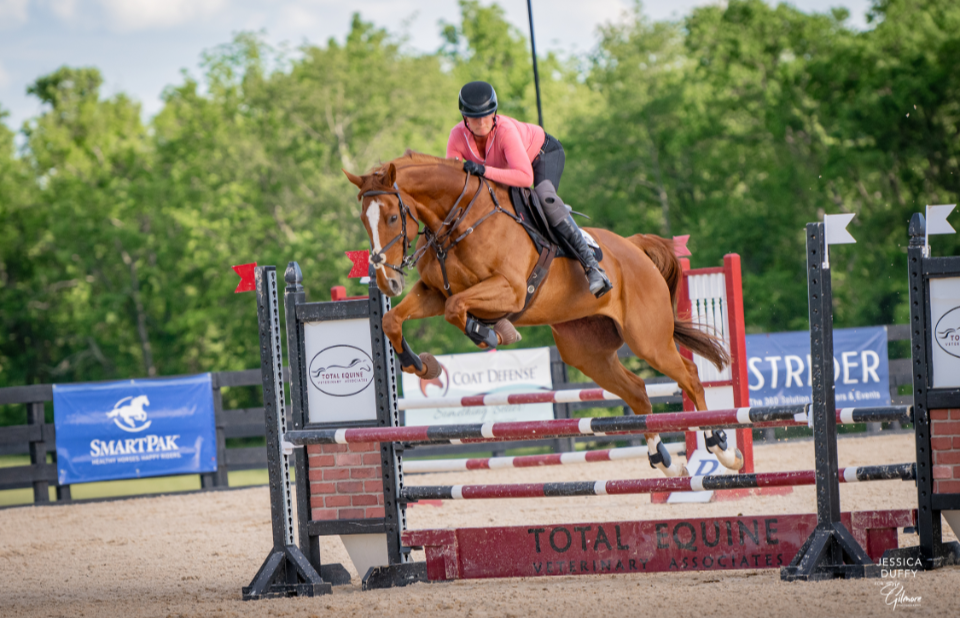This was a signification weekend for high performance eventing around the world as the 2018 World Equestrian Games looms less than a month away. The nominated entry deadline is tomorrow, Monday August 13, and are still waiting for team confirmations from heavy hitters including Australia, Great Britain and France. For many, this weekend was a last chance to impress selectors, so we saw great competition across the continent and the U.K. at Hartpury, Strzegom and Haras du Pin.
Hartpury International

Tina Cook and Billy The Red. Photo by Gary Partridge/Hartpury International.
Tina Cook has had a bit of a rough year, but it looks to be turning right around as she and Billy The Red won the NAF Magic CIC3* at Hartpury International this weekend. She and Elisabeth Murdoch and Keith Tyson’s 11-year-old Baden-Württemberg gelding (Balou du Rouet X FBW Simply Red, by Stan The Man xx) were moved from fifth to first across the jumping phases adding just 1.2 cross country time penalties to finishing on a 26.8. Tina and “Billy” are both on Great Britain’s long list for WEG.
“Everything fell into place here, he nailed a good test because he is a world-class horse and I’m thrilled — it’s been a while since I’ve had a big win and it was a strong field. The ground was fantastic as was the course, and it was a great prep for the autumn events,” Tina said.
Second place belongs to WEG hopeful Piggy French. She and long listed Quarryquest Echo, an 11-year-old Irish Sport Horse (Clover Echo x Royal China, by Cavalier Royale) owned by Jayne McGivern, added only 0.4 cross country time penalties for a three-phase score of 26.9. Piggy also earned an eighth place result with Trevor Dickens’s Vanir Kamira, who joins his stablemate on the WEG long list.
Sam Ecroyd and his own Wodan III came from outside the top ten to nab third place. The 15-year-old Anglo European gelding (Mr Concorde BJ x Tica, by Corland) had .8 time penalties added to close the weekend on 28.3 points.
In a leaderboard dominated by riders with goals of riding at the World Equestrian Games, Pippa Funnel joins the group after finishing fourth aboard Barbara and Nicholas Walkinshaw’s Billy Walk On, a 9-year-old Anglo European (Billy Mexico x Shannon Line, by Golden Bash). The pair finished on 31.2 points.
Bill Levett Elisabeth Murdoch’s 10-year-old Irish Sport Horse Lassban Diamond Lift (Easy Lift x Lassban Chow Bella, by Diamond Chin), who currently sit on Australia’s long list, finished fifth on a score of 31.4.
Hartpury International: Website, Results
[Cook is back on top]
Eventing Nations Cup at Haras du Pin

Maxime Livio and Pica d’Or. Photo via Hara du Pin.
Maxime Livio earned a decisive win of the FEI Eventing Nations Cup this weekend at Haras du Pin aboard Ecurio Livio and Soixante Sieze et Compagnie’s Pica d’Or, a 15-year-old Selle Francais (Tresor du Renom x Joyeuse Be d’Or, by Hurlevent). Leading from the very beginning, the pair finished on their dressage score of 26.4. Maxime also finished 8th with Opium de Verrieres (31.5).

Louise Svensson Jähde and Waikiki 207. FEI/Libby Law Photo.
Louise Svensson Jähde, who has already been named to the Swedish team, and Waikiki 207 secured a clear show jumping round Sunday which moved them from fifth to second overall. The 12-year-old Holsteiner (Quinar x Sila, by San Patrignano Cassini), who is owned by Louise and Hans Thomsen, also finished on his dressage score of 29.4.
Great Britain’s Laura Collett and Mr. Bass earned a smashing third place finish with only 1.6 cross country time penalties marring and overall result of 30.4. This result is a shining addition to the 10-year-old Holsteiner’s (Carrico x K-Jeunesse, by Exorbitant xx) glowing resume as we await the finalization of the British team.
Andreas Ostholt and Eckl Wolf-Dieter’s Pennsylvania 28, an 18-year-old Hanoverian (Pik L x Winona, by Waldstar xx) finished fourth with a score of 30.4, and Richard Coney (GBR) was fifth on 30.6 aboard his own Kananaskis.
Potential Australian representatives in France this weekend included Emma McNab with Fernhill Tabasco, who finished 17th after having one pole down (35.4), Chris Burton with Cooley Lands, who finished 58th after 13.2 time penalties and one rail (45.5), and Robert Palm with Koko Story who finished 64th (51.4).
Looking to the team standings, France won gold in front of the home crowd, followed by the Netherlands for silver and Germany earned bronze.
FEI Nations Cup at Haras du Pin: Live Scoring, Live Streaming
Strzegom Summer Series

Sandra Auffarth and Viamant du Matz. Photo by Leszek Wójcik/Strzegom Horse Trials.
Reigning world champion Sandra Auffarth had a foot perfect weekend in the CIC3* class with Nikolaus Prinz von Croy’s Viamant du Matz. She and the 9-year-old Selle Francais stallion (Diamant de Semilly x Heralina, by Voltigeur le Malin) were the only pair to manage the time on cross country, and they kept on their dressage score of 28.8—a result which earned them the spot as first reserve pair for the German team at the World Equestrian Games.
“I had a great feeling yesterday in the cross country and I was very proud of my horse. I had a good feeling about the showjumping, because my horse is a good jumper. I’m very very happy, my test went really good for me and my horse. I think the showjumping course was quite difficult, but it made it exciting and fun to watch for the audience,” Sandra said.
Christoph Wahler (GER) and his own Carjatan S, a 9-year-old Holsteiner (Clearway x Kajenna, by Galant Vert), came in second with 0.4 time penalties added for a final result of 30.2. Andreas Dibowski secured third aboard FRH Corrida, a 9-year-old Hanoverian (Contendro I x Expo, by Espri) owned by BG Corrida. This duo finished with 32.7 points. Andreas also finished fifth (39.2) with Susanne Heigel’s It’s Me xx.
Standing European champions Ingrid Klimke and SAP Hale Bob OLD slot into fourth place. Ingrid’s 14-year-old Oldenburg (Helikon xx x Goldige, by Noble Champion) took an easy cruise around the cross country for 8.8 time penalties added for a final mark of 34.
Both Andreas and Ingrid were named to the German WEG team shortly after the conclusion of show jumping. You can read the team announcement at this link.
Joining Ingrid in Tryon will be Michael Jung, Kai Rüder and Julia Krajewski, who finished 7th, 12th and 14th, respectively. Michael and his parents Brigitte and Joachim Jung’s fisherRocanna FST, a 13-year-old German Sport Horse (Ituango xx X Rose II, by Carismo) finished with 41.3 points after a confident spin around cross country added 13.2 points. Michael also won the CCI2* with Maria Stein’s Corazon.
Kai and Colani Sunrise, a 12-year-old Oldenburg (Chico’s Boy x Larissa, by Laudatio) owned by Bernhard Reemtsma. 15.6 time penalties were added to their dressage score for a weekend result of 45.8.
Fresh off their win at Aachen, Julia and Chipmunk FRH, a 10-year-old Hanoverian (Contendro I X Havanna, by Heraldik I) owned by Dr. Hilmer Meyer-Kulenkampff had the same finishing time as Michael and Roxy, but also had to poles in the show jumping for a final score of 48.4.

Julia Krajewski and Samourai du Thot. Photo by Leszek Wójcik/Strzegom Horse Trials.
In the CIC2*, Julia Krajewski took top honors with veteran partner Samourai du Thot. The 12-year-old Selle Francais (Milor Landais x Melitos du Thot, by Flipper d’Elle) looks to be coming back into form after elimination at Aachen CIC3* last month. This weekend he added 4.4 cross country time penalties to finish on 27.6.
Strzegom Summer Tour: Website, Live Scoring








































